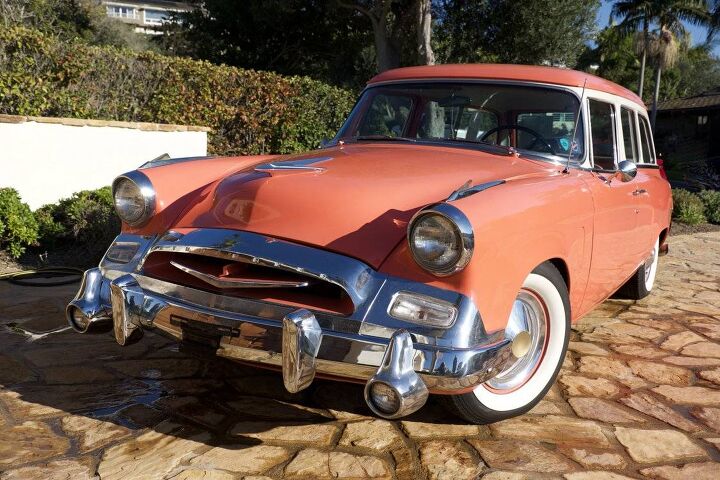Rare Rides: Hop in a 1955 Studebaker Conestoga Wagon

Today’s Rare Ride is a peachy two-door wagon from a company in South Bend, Indiana that would cease to exist about a decade later.
It’s a Studebaker Champion Conestoga, from 1955.
The Champion line started in 1939 as Studebaker’s full-size offering. The company was desperate to improve its financial situation after poor sales in 1938 attacked the balance sheet. The Champion was all new, intended as a free-standing clean break for the company. Designers were not saddled with parts-sharing requirements from Studebaker execs, but were reminded that the Champion was to be as light as possible. The resulting two- and four-door sedans were indeed lighter than competitors, and came equipped with a 2.7-liter inline-six.
The Champion proved a success, seeing redesigns in 1942 and 1947. A third generation released for ’47 saw the lineup expand into the convertible, coupe, and station wagon realms.
By the early Fifties, the Champion was showing its age via upright and stodgy post-war styling. That changed in 1953 with the debut of a fourth-generation model. Studebaker hired a designer from Raymond Loewy’s design studio and told him to modernize. A part of said modernization was a class revision, from full-size to midsize.
What didn’t get modernized was the power motivating all Champions. Through the 1954 model year, Studebaker still employed the same 85-horsepower inline-six as in 1939, albeit enlarged to 2.8 liters. That same year, the Conestoga wagon joined the lineup. Studebaker gave in to modernity for 1955, offering an enlarged version of its old engine. The new displacement was a full three liters, and power jumped to 101 horsepower. Heady figures!
But sales were falling for the Champion line, and an independent Studebaker could not compete on price with competition at the Big Three. A final, fifth-generation Champion arrived for 1957, offered with less equipment and a lower price tag than previous generations. The company renamed its new affordable car the Champion Scotsman, and then just plain Scotsman.
While Studebaker offered a V8 for the final Scotsman (more than doubling the power figure), by that point the changes made little difference. The fifth-gen Champion was cancelled in 1958 after just two model years. The writing was on the wall for the rest of Studebaker as well, and the company officially folded in 1967.
Today’s Rare Ride is a beautiful Conestoga wagon from 1955. Well-equipped with air conditioning, it has 42,000 miles on the odometer and asks $29,500.
[Images: seller]

Interested in lots of cars and their various historical contexts. Started writing articles for TTAC in late 2016, when my first posts were QOTDs. From there I started a few new series like Rare Rides, Buy/Drive/Burn, Abandoned History, and most recently Rare Rides Icons. Operating from a home base in Cincinnati, Ohio, a relative auto journalist dead zone. Many of my articles are prompted by something I'll see on social media that sparks my interest and causes me to research. Finding articles and information from the early days of the internet and beyond that covers the little details lost to time: trim packages, color and wheel choices, interior fabrics. Beyond those, I'm fascinated by automotive industry experiments, both failures and successes. Lately I've taken an interest in AI, and generating "what if" type images for car models long dead. Reincarnating a modern Toyota Paseo, Lincoln Mark IX, or Isuzu Trooper through a text prompt is fun. Fun to post them on Twitter too, and watch people overreact. To that end, the social media I use most is Twitter, @CoreyLewis86. I also contribute pieces for Forbes Wheels and Forbes Home.
More by Corey Lewis
Latest Car Reviews
Read moreLatest Product Reviews
Read moreRecent Comments
- El Kevarino There are already cheap EV's available. They're called "used cars". You can get a lightly used Kia Niro EV, which is a perfectly functional hatchback with lots of features, 230mi of range, and real buttons for around $20k. It won't solve the charging infrastructure problem, but if you can charge at home or work it can get you from A to B with a very low cost per mile.
- Kjhkjlhkjhkljh kljhjkhjklhkjh haaaaaaaaaaahahahahahahahaha
- Kjhkjlhkjhkljh kljhjkhjklhkjh *Why would anyone buy this* when the 2025 RamCharger is right around the corner, *faster* with vastly *better mpg* and stupid amounts of torque using a proven engine layout and motivation drive in use since 1920.
- Kjhkjlhkjhkljh kljhjkhjklhkjh I hate this soooooooo much. but the 2025 RAMCHARGER is the CORRECT bridge for people to go electric. I hate dodge (thanks for making me buy 2 replacement 46RH's) .. but the ramcharger's electric drive layout is *vastly* superior to a full electric car in dense populous areas where charging is difficult and where moron luddite science hating trumpers sabotage charges or block them.If Toyota had a tundra in the same config i'd plop 75k cash down today and burn my pos chevy in the dealer parking lot
- Kjhkjlhkjhkljh kljhjkhjklhkjh I own my house 100% paid for at age 52. the answer is still NO.-28k (realistically) would take 8 years to offset my gas truck even with its constant repair bills (thanks chevy)-Still takes too long to charge UNTIL solidsate batteries are a thing and 80% in 15 minutes becomes a reality (for ME anyways, i get others are willing to wait)For the rest of the market, especially people in dense cityscape, apartments dens rentals it just isnt feasible yet IMO.






































Comments
Join the conversation
A very nice Resto - Mod indeed . I love station wagons . -Nate
Nope!